|
|
Review of GSM-handset Nokia 6233
Live photos of Nokia 6233
Software features of S40 3d Edition
The world’s largest mobile phones manufacturer, Nokia, not always was topping a number of niches, for example the share of handsets for youth was almost free of the company’s presence 10 years ago. The release of Nokia 3210 and consequent development of the series 3000 were the first steps back then, which have granted fame and reputation to the company. Nonetheless the market has never experienced lack of solutions for businessmen by Finnish manufacturer. It was enterprise niche, which has molded the company into the way we see it nowadays. While the design of series 7000 and 8000 has always been open for any fresh ideas and groundbreaking concepts, the company’s always stuck to already proven style and fashion, when speaking about 6000.
The first device belonging to series 6000, which made it to the top of all charts, was Nokia 6210. It’s important to know that before that Nokia’s handsets were in fairly good demand, yet a rapid growth of GSM market roughly concurred with the release date of the 6210. The model was publicly demonstrated for the first time in March of 2000, and a bit later on, in September, all stores received the supplies. In fact the 6210 didn’t have any competitors to reckon with, other than the earlier released Siemens S35i. And as by that moment the S35i had already managed to hit good sales, for some markets including the Russian one, the whole enterprise segment came down to the rivalry between Nokia 6210 and Siemens S35i. The fact of the matter is that there were no alternatives on the market at that time – Ericsson-branded handsets were already in the twilight of their life.
The commercial success of Nokia 6210 called into being not only the following model, Nokia 6310 (with Bluetooth connectivity and slightly altered software part), but also an extra version of the original model (silvery Nokia 6210 with improved battery and bundled Bluetooth). Favorable perception of Nokia 6210 secured a prolonged life cycle for that product – even today I see it turning up, for example my parents have been using for nearly 5 years that Nokia 6210 Cyber Silver. Little used and well-treated, this device looks almost as if it is out of the box. As for me, the first business handset I used was Nokia 6210, which served me for 2.5 years. Even though it obtained numerous scratches and a small gap on the rear panel, the software part was operating flawlessly. The only reason, which forced me to buy a replacement, was my friend, who cracked the phone’s display – otherwise I would have used it until its “natural death”.
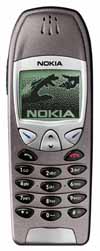
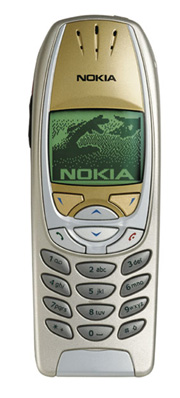
Having spoken in the circle of my friends about probable successors to their Nokia 6210s (or Nokia 6310s), I found out that many of them have predefined the 6230 as an equal replacement (however at the time there was already some kind of competition created mostly by Sony Ericsson and its T610). The brand loyalty expressed to Nokia was overwhelming, which made it possible for Nokia 6230 to soar up in charts and paved the way for the release of Nokia 6230i. All these devices were competing in most cases with solutions by Sony Ericsson, rather than with Siemens-branded handsets, as the latter ones were lacking technological edge and couldn’t keep up the set release dates. All this eventually led to a binary choice on the market of business-centric phones – Nokia or Sony Ericsson. In order to promote their models in a way different from Nokia’s one, over at Sony Ericsson they made up advertising campaigns, highlighting their most attractive capabilities (camera). But after all, there were still direct rivals with Nokia. And such complicated method of promoting provided amusing benefits – a model, seemingly aimed only at the younger share of the audience, Sony Ericsson K700i, was taken as a business handset, and ended up in hands of not only teenagers, but also managers holding high posts. It indicates, in other words, that the design itself wasn’t the most crucial point for them, and that fact has changed manufacturers’ idea of target audiences and their fusion.
At the release of Nokia 6233 the market had been experiencing a remarkable period, distinctive for Nokia’s domination over the business-aimed niche – all major markets ware filled up with Nokia 6230i. Not the last role in groundbreaking sales was played by operators, which were intensively promoting it, while the 6230i’s main competitor, Sony Ericsson K750i trumped it functionality-wise but in the end withdrew due to weak marketing, lack of supplies etc. However Sony Ericsson was still a very credible manufacturer with its own solution and claims to the crown, and it was not left unnoticed.
Model Nokia 6233 is destined for strengthening Nokia’s supremacy on the market of business-handsets even more – in fact it is a well-contemplated phone appeared in order to counter solutions by Sony Ericsson, and partly by Samsung. “Innovations” has always been inapplicable to Nokia’s classic series – they’ve rather absorbed like a sponge all the best features ever embedded in other line-ups. At that they’ve always proposed the best possible price/quality ratio. With the advent of Nokia 6233, it seems the old concept is fading away, as the brand-new idea of innovation is taking over the classic series.

The first and at the same time the most significant change in the approach to creation of a business-solution was alteration of the very design concept. The model was inspired by the ideas of ex-head of the design department, Frank Nuovo, who is famous mostly owing to his love for fashion handsets and using of metal parts or surfaces with resembling outlook - the past and the present of series 8000 (for example Nokia 8810, Nokia 8800) will give you the definitive idea of that. The history of making of these products is very interesting in itself and in case you don’t remember it, I strongly recommend that you read it.
Actually, Nokia’s cheating on its classic concept of series 6000 exactly with Nokia 6233 is not a coincidence. One of the motivations was the desire for making up vertical line-ups, where phones would have in common not only indexes or the brand in general, but also looks. Such products will be aimed at similar audiences, but will segment the market even further. Let’s see how this is going to work out by the example of Nokia 8800 and Nokia 6233. The resemblance of these models is emphasized with a stainless framing found on the latter handsets, yet the former phone costs thrice as much. Reasoning from the price, you could say that the audiences of these two are never going to fuse or influence each other – indeed, a man who’s bought the 8800 isn’t likely to replace it with the 6233. But the positive image of Nokia 8800 as a luxury-product – that’s what this all about. This move is quite simple and at the same time very efficient – more capable models get released earlier and start building up the name for other phones having somewhat similar design, which will be released earlier. In Nokia 6233’s case, the negative effect cause by the model being different from other handsets of the series gets reduced to the minimum.
Moreover this experiment with resembling designs attracts some youth as well, since the handset doesn’t look too boring for them anymore. The phenomenon of any business phones regardless of manufacturer is that up to a third all purchases is made by young people. So Nokia has decided not to waste that chance and try to make this audience loyal as well.

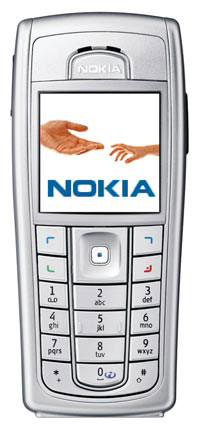

The model comes in two different trims – Classic black and Silver Alloy. The silver-grey finishing resembles the previous model of this line-up in some ways – the handset doesn’t look striking and rather leaves an impression of a device belonging to a calm and adequate person. At the same time the black color scheme is completely opposite to what we described above – the edging made of stainless steel and chromium-coated framings between the keys do the whole job alone and make the phone look austere and elegant.


The material applied to the rear is a special, so called soft-touch plastic, possessing excellent tactile feelings. While it feels nice, such combination of smooth plastic parts and metallic framings is something new. Moreover, in order to make the framings glitter even more, they made the keypad of glossy plastic. All in all this doesn’t cause any gripes and makes the phone look more luxurious.
Measuring 108õ46õ18 mm in size and weighting 112 grams (with a plugged in memory card, officially announced weight is 110 grams), the 6233 slips in just about any pocket or purse. Even though it weights a little bit more than most of today’s phones, Nokia 6233 is equal in this parameter to the competing solutions. On the whole I don’t find any shortcomings I would have to seize upon – the model is very handy in operation, especially owing to its top-notch keypad. The buttons in the side vertical rows stick out slightly, all keys have very soft click and great feedback, I will even dare to say that it’s not only a trumping keypad on the current market, but one of the best ever. The four-way navigation key and the “OK” button inside it are also very easy to manage. The keypad is lit in pale-blue; although it’s quite dim, the experience is mostly favorable.
Video, comparison of dimensions with the 6131, keypad of the 6233 (wmv, 1.8 Mb))>>>



One of Nokia 6233’s unique features is presence of side stereo-speakers, whose grills are positioned more towards the upper end of the handset. Of course, you might say that it’s not the first time when Nokia embeds stereo-speakers – it actually did that in S40-based handsets earlier, for example in Nokia 7370. But the 6233 is the first phone to feature such big speakerphones (11x15 mm). For the time being not a single manufacturer can offer even somewhat close solutions – over the past few months we saw only Motorola E398, Motorola E1 boasting something similar. The loudspeakers found on Motorola’s products were quite bulky and provided really impressive bass and deep sounding; Nokia 6233 shows off slightly worth quality, but still has some trumps in its sleeve – when it comes to playing back music indoors (not on the street), the 6233 is a powerhouse, offering everything you need. However the handset has a bit less loud overall ring tones volume than other Nokia’s latest proposals like Nokia 6131. The tunes sound better, purer, but quieter. Though the difference is eluding and even might be not noticed, since you will not miss a call anyways. A fact, deserving a special note is that Nokia 6233 easily handles tunes found on Vertu-branded handsets, which is extremely rare nowadays – really, they sound so alike, that sometimes I couldn’t figure out which of the phones is ringing (Vertu offers louder tunes, but when it’s in pocket you won’t hear that).
Video, music capabilities of the device (wmv, 5 Mb)>>>

The display adopted by Nokia 6233 is a QVGA one, powered by TFT technology (262 K colors, which are all bright and vivid) with a resolution of 240x320 pixels (diagonal 2 inches, 31x41 mm). The manufacturer hasn’t included any type of backlighting adjustment (intensity, duration), i.e. the screen is always evenly backlit, which allows saving a bit of charge. Nevertheless the user is enabled to choose standby screensaver and backlighting mode (on/off) – in the latter case, if the backlighting will be turned off, the information will remain visible indoors but only at certain angles. Apart from that you can completely switch off the screen, so that it will turn black with no information being displayed on it. In light of the screen having a mirror layer, it doesn’t fade in the sun and ensures that all data will be still readable.

Quality-wise (diagonal, picture quality) the screen found on the 6233 yields to Nokia 6131, but still claims the leading spot in its class. On the whole the display is well-made; I couldn’t find any faults with it.

The top rim houses the power button, doubling as a profile switcher while in standby mode. The left side features a dedicated Push to Talk key, which cannot serve as a shortcut for any other function, and that’s frustrating, since this service remains useless for many.

The left plate also plays host to a microSD expansion slot, which supports hot-swap. Turning the handset to the right reveals rocker volume key and camera shortcut button, just as on camera-centric phones by Sony Ericsson, which have seemingly set the fashion of controls lay-out. The Infrared window is mounted on the right as well.

The bottom end offers a standard interface connector Pop Port with the charger slot being placed right next to it (thin plug). Holes for a carrying strap are also there.
Video, handset’s outlook (wmv, 1.9 Mb)>>>

The rear panel would’ve been completely bald if camera lens and a small-sized mirror weren’t there. The camera module itself is a 2 Mpix CMOS-based one, which is quite typical for the company. The silver edging around the lens is made of plastic, exposed to wear and tear, in other words it will get scratched and soiled in no time. The glossy framing is also a magnet for various scratches and other kinds of mechanical damage.

The battery cover is well-tuned and firmly sits in its slot. Having removed it you will see an 1100 mAh capable battery, namely a Li-Pol one - the BP-6M. Nokia claims that it provides 340 hours in standby mode and up to 4 hours of talk time. At average loading, we managed to squeeze two days of lifetime (2-3 hours of music playback, a bit of WAP browsing, calendar, up to 20 minutes of games and 1 hour of calls). Should you be easy on calling and music, the charge will last nearly 3 days, however majority of active users will have only one day of lifetime.


When we attempted to listen to music at full blast (in headphones), the 6233 passed the muster with the result of 9.5 hours – for radio the lifetime will be pretty much the same. The handset charges from empty to full in approximately 2.5 hours. Taking account of this handset’s spec sheet and comparing the obtained results with its rivals, I conclude that two days is quite standard lifetime. The display at that isn’t power hungry, so turning the screen off while in standby mode will give you 5-6 percent more time at best.
Nokia 6233’s software features
The handset comes along with a 64 Mb memory card, which allows the manufacturer to claim 70 Mb of available storage – indeed, all you need to do is to open the box and plug the memory card in. However there are some hidden dangers in this – for some markets the bundled card already contains pre-installed content, for example games and useful apps, while for the other ones (including Russia) it is completely wiped. Installing basic applications found on the memory card isn’t a big deal in case you have Internet access. So in a nutshell, all you have initially is 6 Mb of manageable memory, which is quite little for modern handsets.
Unlike the previous models, data received via Bluetooth and Infrared get stored in the place which has more free memory, at that even big files, taking up more memory than the phone can offer, are moved to “Received” folder on the memory card.
Bluetooth. Everything said about Nokia 6131 holds true for the 6233 – support for A2DP profile is missing, so there is no way you can make use of a wireless headset, even though distorted monophonic sound can be transferred to them. The manufacturers has announce the following supported profiles for the given model:
- Headset;
- Dial Up Networking;
- Object Push;
- File Transfer;
- Hands-Free v1.5;
- SIM Access.
A thing of note is that even Bluetooth implementation is far from perfect: during the month, when I was playing around with the 6233, I encountered refuses to synchronize with PC, futile attempts to connect to PC with activated auto-connect and similar minor nuisances a number of times. Yet when handling a headset, the phone does very well – it is rather synchronization with PC and other devices that causes most of issues. Here I should say that for majority of users, these drawbacks are more likely to remain unnoticed, or occur very rarely. But anyway, when judging this very parameter, Nokia 6233 is far inferior to handsets by Sony Ericsson, which offer more credible compatibility with various external devices.
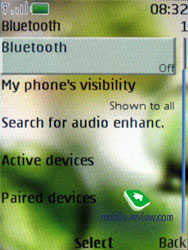 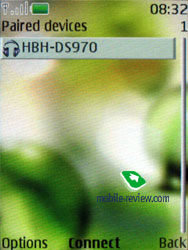
The handset carries Bluetooth ver. 2.0 with the support for EDR.
Software features of S40 3rd edition
You can read a definitive description of the handset’s features and its interface in a special article – we strongly recommend doing so for better understanding of functionality of the reviewed model.
This paragraph covers all software functions, requiring a close-up, but which belong to basic functionality only. You may even say, that this is the list of those moments that I did not find being convenient, common or on the contrary, interesting. Full description of functionality can be read in next section of this review, which will be dedicated exclusively to software peculiarities, without drawing special attention to advantages and disadvantages. Software standardization has reached S40 platform too, which forces us to divide the material in such way.
Demo-mode. Allows running the handset without a SIM-card onboard, you get access to majority of functions. Such feature is still a rare thing on ordinary handsets, that is why it is very pleasant.
Flight Mode. The network part can be turned off in case you are in a plane or wherever mobile phones are prohibited.
Java-applications. Like any S40-powered handset, this phone can’t minimize applications, in other words if you’ve called up a particular app, you have to either work with it or shut down (radio and music are the only exceptions). Against the background of devices coming from the Sony Ericsson’s latest generation, empowering users not only to keep applications in background mode, but also to run up to three programs plus the media player, such solution appears pretty archaic. This is the place where the Nokia’s offspring yields to other devices. Size limitation for application is 1mb (JAR), heap size – not more than 2mb.
Uploaded applications and DRM. Having received applications via WAP or from a PC, you will surprisingly find out that after installation you loose the last bit of control over them (this category of apps includes unprotected test utilities). An attempt to send such application to another device via Bluetooth will result in a failure since you don’t have the right to do so. At times it frustrates, in light of not knowing how to get rid of this restriction. Why would they block sending applications if DRM-rights checking cannot be implemented on the device – I’m not the one to be asked.
Calls list. Pressing the call key brings up the list of dialed numbers only. However, the very process of communication, as many see it, requires not only making, but also receiving calls. I frequently need to call back people, whose calls I’ve missed – when there are more than two of them, it’s impossible to do that without having to peek in the calls record. To access to general list, you will need to perform at least 3-4 actions, and this is pretty much inconvenient.
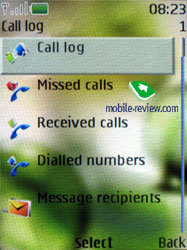 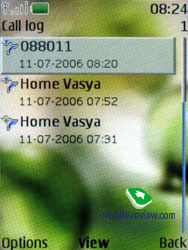
Incoming messages. The display doesn’t offer the information on sender – only amount of messages (e.g you have one unread message), and this isn’t the exact way it should be. In viewing mode name is taken from the phonebook.
BT-devices searching. The handset is always searching for new devices located nearby; you can’t pick a device residing in the list of already paired ones, and thus end up by having to spend a bit more time.
Phonebook. Unlike Nokia 6131 and similarly to Nokia 6280 phonebook has only 500 entries to fill, meanwhile standard for all business solutions made by Nokia was 1000 entries. Explanation of this problem is old platform which is used for 6233’s basis, it does not have enough internal memory and firmware of 3G phones requires more space. We get quite illogic solution which will become the limitation for certain user, a barrier which they will not cross (at least some of our readers were convincing me that they need more than 500 entries for phonebook).
 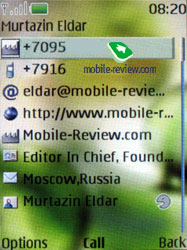
Email client. Email client which is installed in this handset is so advanced compared to previous, that it should be described separately. This is not an ideal solution, more than that it will not suit many business-users, but software itself is a great leap forward. You will be able to read about email client in next part of our review.
Voice dialing. Tags automatically get assigned to contacts in the phonebook, without having to train before. The flaw here is arguable reliability when it comes to browsing a mixed phonebook (i.e. which contains entries in two languages) or a lot of complicated last names with similar spelling (the phone simply goes mad and offers completely opposite names). Nonetheless the main part of the target audience usually doesn’t need to store so many entries and thus won’t have such issues.
Themes. There are few themes preinstalled, they are all standard and do not offer main menu’s icon customization, everything was done in order to save some memory. It is easy to download new themes, which are a lot more colorful and interesting than standard ones.
Lack of possibility to copy files – you can only move files from one place to another, there is no such operation as copying, which is a limitation.
Preinstalled applications
Applications may differ depending on country device is being shipped in, but they are similar for most markets. There is flash-based game Sudoku, and Nokia’s classics – Snake III (3d-edition).
 
 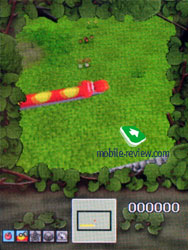
As for functional applications – there is Converter II (converting one units into others), Translator (simple dictionary with word search) and World Clock.
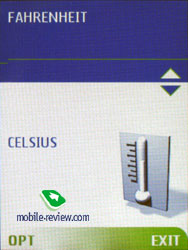 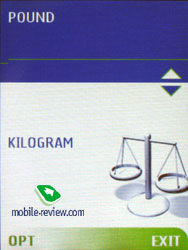
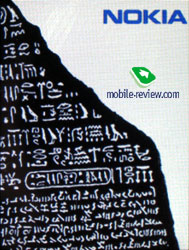 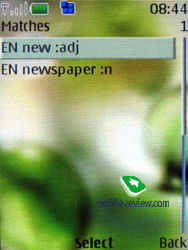
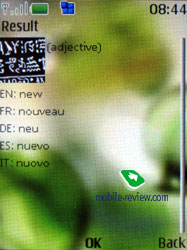 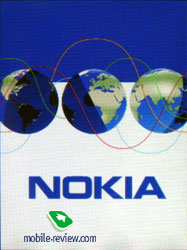

Memory Card stores Soccer 3D, Rally 3D, Nokia Sensor and Nokia Wireless Presenter.
There are no applications that would help you opening office files or pdf in this model, there is no way to install them either (except for book-reading software).
Handset’s performance
Model’s interface is acceptable in terms of speed, it does not have any problems. We have used Jbenchmark tests in order to verify handset’s performance, according to its results this is a slightly above average handset for its segment, it shows nice numbers for a model of previous generation. Compared to very same Sony Ericsson K800 we can see that it is inferior, these are two different device classes (in terms of Java at least).
Jbenchmark 1
Date 17.06.2006
Model name Nokia 6233
Firmware version
Jbenchmark 1 1.1.1
Version
Total Score: 1889
Details:
Text 434
2D Shapes 445
3D Shapes 316
Fill Rate 240
Animation 454
Screen Width 240
Screen Height 250
Color Screen true
Number of Colors 16777216
Double Buffer true
Total Memory 2097152
Free Memory 1878256
MicroEdition Configuration CLDC-1.1
MicroEdition Profiles: MIDP-2.0
Microedition Platform: 3,5
Microedition Encoding: ISO-8859-1
Microedition Locale ru-RU
Jbenchmark 2
Version 2.1.1
Total Score: 243
Details:
Image Manipulation 189
Text 220
Sprites 423
3D Transform 302
User Interface 158
Screen (canvas) Width 240
Screen (canvas) Height 250
Color Screen true
Number of Colors 16777216
JPEG Support true
Transparency (Alpha Level) 256
Double Buffer true
Total Memory 2097152
Free Memory 1281700
MicroEdition Configuration CLDC-1.1
MicroEdition Profiles: MIDP 2.0
Microedition Platform: 3,5
Microedition Encoding: ISO-8859-1
Microedition Locale ru-RU
Jbenchmark 3D
Perfomance
Jbenchmark3D HQ: 133
Jbenchmark3D LQ: 262
Triangles ps: 34713
kTexes ps: 1351
version: 3.1.0
Screen(canvas)width: 240
Screen(canvas)height: 320
3D Subsystem:
M3G Version: 1,1
Antialaising: false
True color: false
Dithering: false
Mipmapping: true
Perspective correction: true
Local camera lighting: false
Max lights: 8
Max Viewport dimensions: 1024
Max Texture Dimensions: 256
Max Sprite Crop Dimensions: 1024
Max Transforms Per Vertex: 4
Number of Texture Units: 2
Other properties
Color Screen true
Number of colors 16777216
Transparency (alpha level) 256
Double buffer true
Total memory: 2097152
Free memory: 398212
MicroEdition Configuration CLDC-1.1
MicroEdition Profiles: MIDP 2.0
Microedition Platform: 3,5
Microedition Encoding: ISO-8859-1
Microedition Locale ru-RU
Microedition Communication ports: COM0
Microedition Hostname: null
Jbenchmark HD
Version 4.0.3
Rendering Quality
Bilinear filtering: 99%
Trilinear Filtering: Failrule (80%)
Perspective correction: Failrule (85%)
Z-buffer depth: 14 bit or higher
Perfomance
Smooth triangles: 65232
Textured triangles: 53942
Fill rate: 1620 kTexels
Gaming: 116 (3.9 fps)
3D Subsystem:
M3G Version: 1,1
Antialaising: false
True color: false
Dithering: false
Mipmapping: true
Perspective correction: true
Local camera lighting: false
Max lights: 8
Max Viewport dimensions: 1024
Max Texture Dimensions: 256
Max Sprite Crop Dimensions: 1024
Max Transforms Per Vertex: 4
Number of Texture Units: 2
Other properties
Microedition Platform: 3,5
Number of colors 16777216
Transparency (alpha level) 256
Double buffer true
MicroEdition Configuration CLDC-1.1
MicroEdition Profiles: MIDP 2.0
CLDC (JSR 30, 139) 1,1
Encoding: ISO-8859-1
Locale ru-RU
Total memory: 2097152
Free memory: 1014240
MIDP (JSR 37, 118, 271) 2
Form width: 222
Form height: 250
Canvas Width: 240
Canvas Height: 250
Fullcanvas Width: 240
Fullcanvas Height: 320
Canvas doublebuffered: true
Color: true
Colors: 16777216
Alpha levels: 256
FC (JSR 75) 1
PIM (JSR 75) 1
Bluetooth (JSR 82) 1
Connected inquiry: true
Connected inquiry scan: true
Connected page: true
Connected page scan: true
Master switch: false
Connected inquiry scan: true
OBEX (JSR 82)
WMA (JSR 120, 205) 2
Smsc N/A
MMAPI (JSR 135) 1,1
Snapshots encodings: encoding=jpeg
Video capture: true
Video encodings: encoding=3gp
Streamable contents: none
Mixing: false
Recording: true
Audio encodings: amr, amr-nb
Audio capture: true
Web Parser (JSR 172): 1
WEB RPC (JSR 172): no
SATSA (JSR 177): no
Location (JSR 179) no
SIP (JSR 180): no
JTWI (JSR 185) 1
CHAPI (JSR 211): no
SVG (JSR 226): 1
AMMS (JSR 234): no
Global (JSR 234): no
Camera. This handset has 2mpx camera (CMOS) which is not that much according to today’s standards, but it is still pretty enough for a middle class model. Nokia decided not to bet on camera part, it is more of an optional feature. This is why camera’s module that was selected for 6233 is one of the cheapest, and provides average quality, if not to say bad one. In dark conditions camera refuses to work normally, exposure time increases and every movement your hand makes within that time leads to blurry image in the end. Dark conditions are considered daytime in summer on a street where there’s not much of sunlight. Indoors it is even worse. In case you consider camera being a nominal solution – it is pretty much comfortable, at same time handset was unable to reach at least Sony Ericsson’s K750i level.
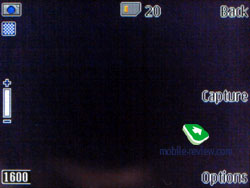 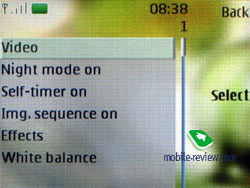
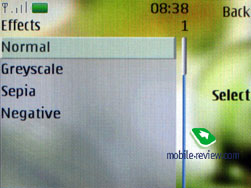 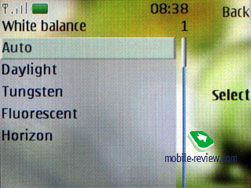
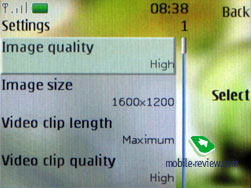 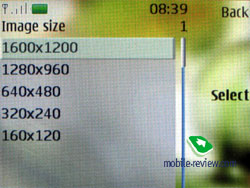
 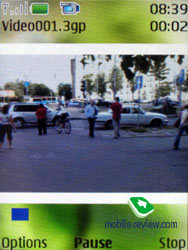
Following resolutions are supported:
- 1600x1200;
- 1280x960;
- 640x480;
- 320x240;
- 160x120.
Two minimal resolutions were added for creating photos that would fit as wallpapers for display. Three JPEG compression types are supported: basic, normal, high. Considering the fact that photos do not blow your imagination away, it is better to set maximal quality, it won’t be worse than it is.
Shutter sound can be disabled, there is 8x digital zoom, but there is no reason to use it. You can save photos on both memory card and internal memory.
Some effects can be applied to already made photos, should they be used initially – it is up to you to decide. Such effects as Greyscale, Sepia, Negative are available.
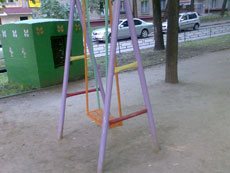 |
 |
(+)
maximize, 1600x1200, JPEG |
(+)
maximize, 1600x1200, JPEG |
 |
 |
(+)
maximize, 1600x1200, JPEG |
(+)
maximize, 1600x1200, JPEG |
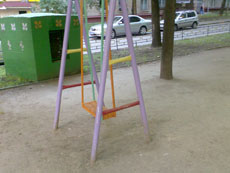 |
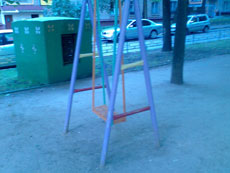 |
(+)
maximize, 1600x1200, JPEG |
(+)
maximize, 1600x1200, JPEG |
 |
 |
(+)
maximize, 1600x1200, JPEG |
(+)
maximize, 1600x1200, JPEG |
Those who love to shoot a lot of photos at once, there is corresponding mode for you – camera makes up to 3 shots at a time, all settings remain similar to selected for single shot, including resolution. There is auto-timer for self-shots.
I offer you to look at photos made in different conditions, and I believe you will be able to conduct your own opinion about their quality (maximal resolution, best quality). For comparison we offer you shots made by Sony Ericsson K750i, Sony Ericsson K800i in maximal resolution and quality. I should remind you that Sony Ericsson K800i has 3.2mpx camera and provides better picture quality de-facto.
 |
 |
6233 (+)maximize, 1600x1200, JPEG |
K750 (+)
maximize, 1600x1200, JPEG |
 |
 |
6233 (+)
maximize, 1600x1200, JPEG |
K750 (+)
maximize, 1600x1200, JPEG |
 |
 |
6233 (+)
maximize, 1600x1200, JPEG |
K750 (+)
maximize, 1600x1200, JPEG |
 |
 |
6233 (+)
maximize, 1600x1200, JPEG |
K750 (+)
maximize, 1600x1200, JPEG |
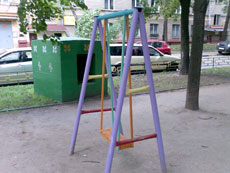 |
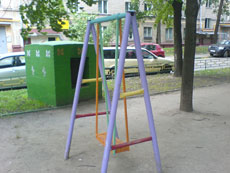 |
6233 (+)
maximize, 1600x1200, JPEG |
K750 (+)
maximize, 1600x1200, JPEG |
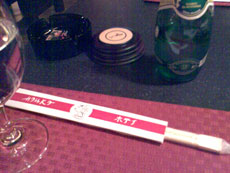 |
 |
6233 (+)
maximize, 1600x1200, JPEG |
K750 (+)
maximize, 1600x1200, JPEG |
 |
 |
6233 (+)
maximize, 1600x1200, JPEG |
K800 (+)
maximize, 2048x1536, JPEG |
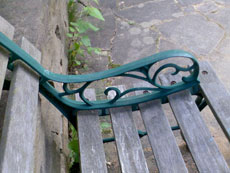 |
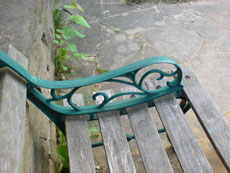 |
6233 (+)
maximize, 1600x1200, JPEG |
K800 (+)
maximize, 2048x1536, JPEG |
 |
 |
6233 (+)
maximize, 1600x1200, JPEG |
K800 (+)
maximize, 2048x1536, JPEG |
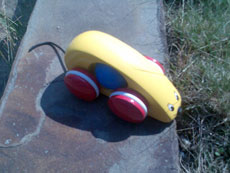 |
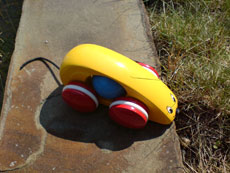 |
6233 (+)
maximize, 1600x1200, JPEG |
K800 (+)
maximize, 2048x1536, JPEG |
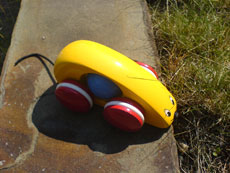 |
|
K750 (+)
maximize, 1600x1200, JPEG |
|
 |
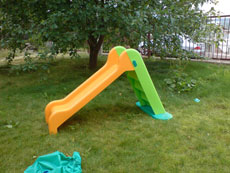 |
6233 (+)
maximize, 1600x1200, JPEG |
K800 (+)
maximize, 2048x1536, JPEG |
 |
|
K750 (+)
maximize, 1600x1200, JPEG |
|
Video. Handset allows recording video in 3GP format, available resolution – 128x96 pixels, or 176x144, 352x288, 640x480 pixels. Recording quality is divided into three parameters. You can limit recording’s length, but it also can be limitless, until memory runs out (of memory card or internal memory). Effects can be applied for video just as they can be applied for photos, they are one and the same. Video looks quite acceptable when you look at it on handset, including maximal resolution. However you will see artifacts when you view same video on PC, but it is still okay to watch, and that’s a great step forward. In case with 352x288 pixel video clips made by Nokia 6233 and same clips made by Samsung phones, Nokia’s ones look better, they have more natural color rendering. Considering fact that video recording is not a very demanded function by majority of users, here it is made without any concerns.
Video samples – High, 640x480 pixels:
Video sample 1 (3GP, 4.4 Mb)>>>
Video sample 2 (3GP, 5.2 Mb)>>>
Video sample 3 (3GP, 5.5 Mb)>>>
Impressions
The volume of 64-tone polyphony is enough for almost any conditions. The receiving part also does fine, as it equals all other phones of the current generation. The silent alarm is average strength-wise, but can be still felt while the handset is in pocket.
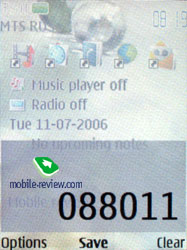 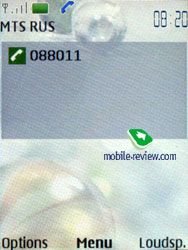
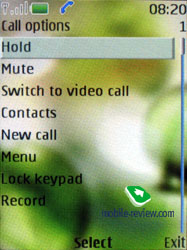
Nokia 6233 price in July has reached 360-380 USD, which is optimal for a product of such class, there are even offers like 320-330 USD. Equivalent model in Nokia’s line-up is Nokia 6131, but here we see better case material, colorful display, clamshell form-factor. Visually model is weaker than Nokia 6233 and by equal or slightly bigger price of Nokia 6131 you should make your choice in favor of first mentioned handset. However bigger part of debates regarding which phone to buy is based on form-factor that you prefer, instead of functionality.
At the moment S40 3rd edition line-up has all form-factors, and speaking of similarities we can mention not only Nokia 6233 and Nokia 6131, but also Nokia 6280. Differences between Nokia 6131 exist since it is a GSM-solution and handset has more memory for basic functions like phonebook (this makes it similar to Nokia 6270 slider). Lack of memory prevented engineers from making a wide set of themes for Nokia 6233, as well as Stereo Widening function, but in most cases it is useless.
As a music solution this handset is very acceptable, however it is weaker than Walkman-solutions in terms of interface convenience, detailed adjustments, but in terms of sound quality it is on their level, and when we’re speaking about loudspeaker mode – it has no competitors on the market at all (stereo speakers play their role in that).
Design is pleasant, numeric keypad is even more pleasant than that, it actually brings joy when you work with that. Considering this parameter as most important one – this model has been a success. There is no main shortcoming of previous models – small display even though with relatively high resolution (208x208 pixels has been inconvenient for many). As a Nokia 6230/Nokia6230i replacement this model looks like a nice choice, there is no reason to hesitate, as there are no alternatives.
At same time Nokia 6233 position on the market is not so lonely at all, direct competitor is Sony Ericsson K800i and this model has some clear advantages, however some weak sides too. We will bring you detailed comparison in the upcoming days, and shall not stop on this one right now. I’d just like to point out that in case with K800i we have a new platform, Nokia 6233 has pumped over the edge with steroids old platform from Nokia. Upcoming models will have a series of principled differences. As for modern day functions, Nokia lacks support of A2DP profile for Bluetooth (not so important for majority), cannot make Java applications run in the background and has limitations for their size. Lack of camera for video calls is hard to consider as shortcoming, this function is not that popular for many. Poor package set makes you want to buy a bigger sized memory card and USB-cable.
But all above mentioned shortcomings are not so important, as we have a big set of 6000x series fans who will find this handset suitable for them. This is an interesting and worthy solution, one of the strongest handsets in its class. Due to adequate pricing model will stay popular, but its life cycle will be around a year. In future it will be replaced with a “I” indexed model, which will be able to finally beat main competitor by some parameters (not by all of them). However by that time main competitor will be able to gain new features too, so the rival between these two promises to be interesting.
For a short resume instead of long story telling, I can bravely say that Nokia 6233 will become a bestseller on the market. Mostly due to loyalty for Nokia’s brand and its excellent perception. But besides that handset has its achievements too, it is a very pleasant and good product. Company was able to recreate esthetics of Nokia 6210 on a modern day level. In my opinion Nokia 6230/Nokia 6230i were singled out of this set of business-solutions, had unbalanced set of functions however there was acceptable price.
SAR factor for this model is – 0.8 watt/kg.
P.S. Firmware 3.70 has a small set of problems, including errors when listing call list (overall list), with more than 58 entries.
Software features of S40 3d Edition
Eldar Murtazin (eldar@mobile-review.com)
Translated by Oleg Kononosov (oleg.kononosov@mobile-review.com), Alexandr "Lexx" Zavoloka (alexander.zavoloka@mobile-review.com)
Published — 02 August 2006
Have something to add?! Write us... eldar@mobile-review.com
|
News:
[ 31-07 16:21 ]Sir Jony Ive: Apple Isn't In It For The Money
[ 31-07 13:34 ]Video: Nokia Designer Interviews
[ 31-07 13:10 ]RIM To Layoff 3,000 More Employees
[ 30-07 20:59 ]Video: iPhone 5 Housing Shown Off
[ 30-07 19:12 ]Android Fortunes Decline In U.S.
[ 25-07 16:18 ]Why Apple Is Suing Samsung?
[ 25-07 15:53 ]A Few Choice Quotes About Apple ... By Samsung
[ 23-07 20:25 ]Russian iOS Hacker Calls It A Day
[ 23-07 17:40 ]Video: It's Still Not Out, But Galaxy Note 10.1 Gets An Ad
[ 19-07 19:10 ]Another Loss For Nokia: $1 Billion Down In Q2
[ 19-07 17:22 ]British Judge Orders Apple To Run Ads Saying Samsung Did Not Copy Them
[ 19-07 16:57 ]iPhone 5 To Feature Nano-SIM Cards
[ 18-07 14:20 ]What The iPad Could Have Looked Like ...
[ 18-07 13:25 ]App Store Hack Is Still Going Strong Despite Apple's Best Efforts
[ 13-07 12:34 ]Infographic: The (Hypothetical) Sale Of RIM
[ 13-07 11:10 ]Video: iPhone Hacker Makes In-App Purchases Free
[ 12-07 19:50 ]iPhone 5 Images Leak Again
[ 12-07 17:51 ]Android Takes 50%+ Of U.S. And Europe
[ 11-07 16:02 ]Apple Involved In 60% Of Patent Suits
[ 11-07 13:14 ]Video: Kindle Fire Gets A Jelly Bean
Subscribe
|



















































































